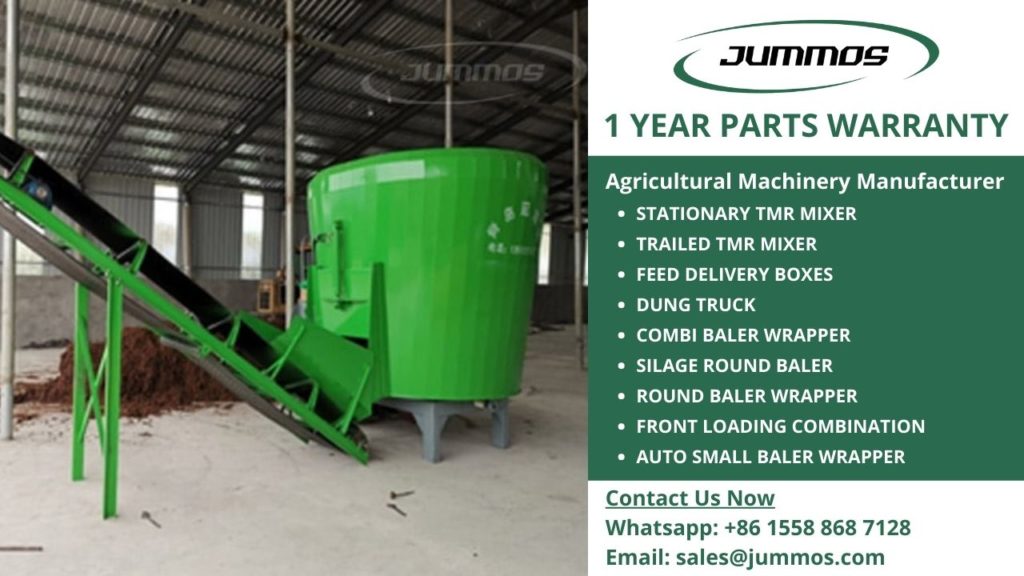In the process of cattle feed manufacturing, mixing is the most important operation. Different ingredients are blended in the appropriate ratios and then distributed thoroughly. The purpose of mixing is to achieve a homogeneous blend, which is then processed into the desired forms, whether packaged or delivered. If the mixture is not well-blended, the quality of the nutritional ingredients cannot be maintained.
Each feed mixer specification can affect the performance of the mixing process, including whether the mixer is new or old, the condition of its parts, cleanliness, and design. Moreover, the types of ingredients also contribute, such as size and form, density, and the order in which ingredients are added. Both feed mixer specifications and the characteristics of the ingredients play cooperative roles in achieving complete and efficient mixing.
Various feed mixer specifications may influence the feed manufacturing mixing process. The two main types of feed mixers, horizontal and vertical, have their own advantages and disadvantages in operation. Let us briefly discuss what to consider before initiating the mixing process.
Contents
Power and Performance
You should check the power requirements of the feed mixer and ensure it is compatible with your tractor. Proper matching allows feed mixing to be done efficiently without excessive power consumption.
Due to the operational demands and the type of material being processed, the feed mixer should be made from durable materials. The walls and blades made of stainless steel will resist erosion. The structure of the mixing area, including walls and floors, should also be strong enough to withstand regular agitation in the mixing chamber.
Physical Operation
A horizontal mixer consists of a horizontal tub with mixing elements. The blades move the material from one end of the mixer to the other, tumbling it as they go. It can incorporate about 8% liquids into a dry mix. Typically, a horizontal mixer can handle 2-3 batches at a time.
A vertical mixer is suitable for small-scale manufacturing operations. To achieve a homogeneous mix, it requires about five times more mixing cycles than horizontal mixers. Due to its tall construction, it may not fit into all facilities.
The stationary feed mixer and the trailing feed mixer from Jummos cater to a wide range of feed mixer specifications, from small-scale operations to larger ones. Their capacities range from 5 kg to 14,400 kg.
Types of Feed Mixers
There are two types of feed mixers used in feed manufacturing: ribbon type and paddle type. The ribbon mixer works by pushing or pulling the materials thoroughly within the mixer. The paddle mixer operates by lifting and folding the ingredients.
The ribbon design is generally more effective in blending materials as it can cover the entire mixing chamber. The paddle design may cause some materials to get stuck in certain areas due to its limited movement.
Liquid Distribution
Horizontal mixers are better than vertical mixers for blending ingredients. However, due to their complex construction, horizontal feed mixers can be difficult to clean completely. Some ingredients may stick to the blades and accumulate. Sticky ingredients like oils, fats, and molasses are necessary to blend with dusty raw materials. These high-moisture materials can promote bacterial growth. To facilitate cleaning, scrapers can be used.
In contrast, vertical feed mixers cannot process liquids completely due to their slow running action. They tend to form clumps coated with particulate ingredients instead of producing a homogeneous mix. However, vertical mixers can be loaded manually and are easy to operate. These low-cost machines are still used for blending materials without liquids.
Related Design and Technology for Feed Mixer Specifications
Horizontal feed mixers have more sophisticated construction, making them more efficient. Vertical feed mixers are only suited to small-scale operations, especially small livestock mills. Consequently, the prices reflect the associated construction technology, with horizontal mixers being more expensive than vertical ones.
Jummos provides the latest technology in feed machine manufacturing at affordable prices. You can choose between single auger or multiple augers to meet your feed mixer specifications. There are also options for the location, such as stationary feed mixers or trailing feed mixers. Each can be customized to meet the specific needs of different farms.

